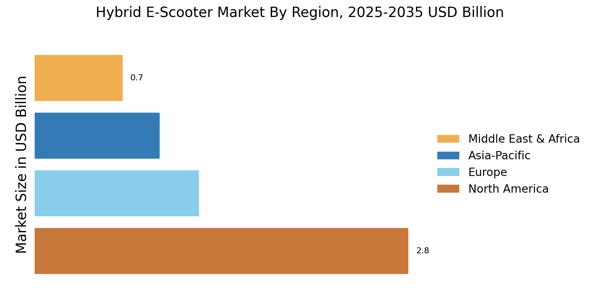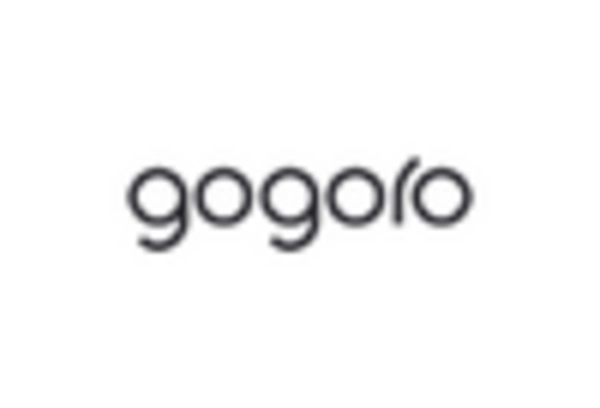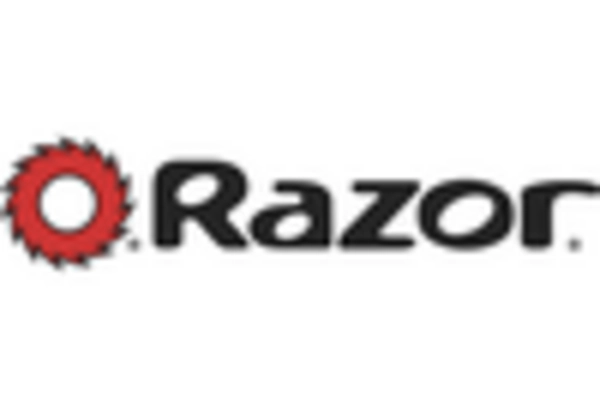Rising Urbanization
The increasing trend of urbanization appears to be a pivotal driver for the Hybrid E-Scooter Market. As more individuals migrate to urban areas, the demand for efficient and compact transportation solutions intensifies. Cities are often characterized by congestion and limited parking, making traditional vehicles less practical. In contrast, hybrid e-scooters offer a nimble alternative, allowing users to navigate through traffic with ease. According to recent data, urban areas are projected to house over 68% of the population by 2050, which could further bolster the hybrid e-scooter adoption. This shift towards urban living necessitates innovative transportation solutions, positioning the Hybrid E-Scooter Market favorably for growth.
Government Initiatives
Government initiatives aimed at promoting sustainable transportation are likely to bolster the Hybrid E-Scooter Market. Many governments are implementing policies and incentives to encourage the use of electric and hybrid vehicles, including e-scooters. These initiatives may include subsidies, tax breaks, and the establishment of dedicated infrastructure such as charging stations and bike lanes. Recent reports suggest that countries are investing heavily in green transportation initiatives, which could significantly impact the hybrid e-scooter market. By creating a supportive regulatory environment, governments are facilitating the growth of the Hybrid E-Scooter Market, making it an attractive option for consumers seeking alternative modes of transport.
Environmental Awareness
Growing environmental consciousness among consumers is likely to propel the Hybrid E-Scooter Market. As awareness of climate change and pollution escalates, individuals are increasingly seeking eco-friendly transportation options. Hybrid e-scooters, which combine electric and traditional propulsion, present a sustainable alternative to fossil fuel-powered vehicles. Market data indicates that the demand for electric vehicles, including e-scooters, has surged, with a notable increase in sales over the past few years. This trend suggests that consumers are willing to invest in greener technologies, thereby enhancing the appeal of the Hybrid E-Scooter Market. The potential for reduced carbon footprints and lower emissions aligns with the values of environmentally conscious consumers, further driving market growth.
Technological Advancements
Technological advancements are transforming the Hybrid E-Scooter Market, making it a dynamic and rapidly evolving sector. Innovations in battery technology, such as improved energy density and faster charging capabilities, are enhancing the performance and convenience of hybrid e-scooters. Additionally, the integration of smart technologies, including GPS navigation and mobile app connectivity, is appealing to tech-savvy consumers. Market analysis indicates that The Hybrid E-Scooter is expected to grow significantly, with hybrid models gaining traction due to their versatility. These advancements not only improve user experience but also contribute to the overall attractiveness of the Hybrid E-Scooter Market, potentially leading to increased adoption rates.
Changing Consumer Preferences
Shifting consumer preferences towards convenience and mobility solutions are driving the Hybrid E-Scooter Market. As lifestyles evolve, individuals are increasingly favoring flexible transportation options that cater to their dynamic needs. Hybrid e-scooters offer a practical solution for short commutes, leisure rides, and last-mile connectivity. Market data indicates a growing trend among younger demographics, who are more inclined to adopt alternative transportation methods. This demographic shift suggests that the demand for hybrid e-scooters will likely continue to rise, as consumers prioritize convenience and sustainability. The Hybrid E-Scooter Market stands to benefit from these changing preferences, positioning itself as a viable alternative to traditional transportation methods.


















Leave a Comment